 To enhance service speed and avoid tariff delays, we've opened a US warehouse. All US orders ship directly from our US facility.
To enhance service speed and avoid tariff delays, we've opened a US warehouse. All US orders ship directly from our US facility.
| Cat. No. | Product Name | Field of Application | Chemical Structure |
|---|---|---|---|
| DC67101 | Ganirelix acetate Featured |
Ganirelix acetate is an antagonist of GnRH that competitively antagonizes the gonadotropic GnRH receptor, thereby mutating the pathway and causing rapid and reversible inhibition of gonadotropin (luteinizing hormone LH and follicle stimulating hormone FSH) secretion. Ganirelix Acetate acts by competitively blocking the GnRH receptors on the pituitary gonadotroph and subsequent transduction pathway. It induces a rapid, reversible suppression of gonadotropin secretion. The suppression of pituitary LH secretion by Ganirelix Acetate is more pronounced than that of FSH.
More description
|
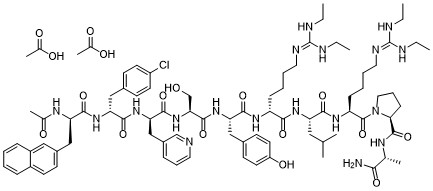
|
| DCC3875 | Octreotideacetate Featured |
Agonist of sst2, sst3 and sst5 somatostatin receptors
More description
|
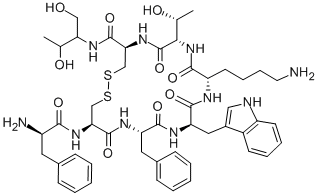
|
| DC67099 | somatostatin Featured |
Somatostatin is a tetradecapeptide which can suppress the growth hormone (GH) secretion and control the pituitary hormone secretion in human CNS.
More description
|
.gif)
|
| DC37766 | Eptifibatide Featured |
Eptifibatide is a potent glycoprotein IIb/IIIa antagonist (GPIIb/IIIa; Kd = 120 nM) that inhibits platelet aggregation. Eptifibatide prevents binding of the adhesion proteins fibrinogen and von Willebrand factor to GPIIb/IIIa on the surface of activated platelets to prevent aggregation and thrombus formation. It inhibits ADP-induced citrated blood aggregation (IC50 = 0.11-0.22 μg/ml) in vitro and in vivo (IC50 = 52 μg/ml in porcine plasma). Formulations containing eptifibatide have been used to reduce risk of thrombolysis in myocardial infarction in patients undergoing percutaneous coronary intervention.
More description
|
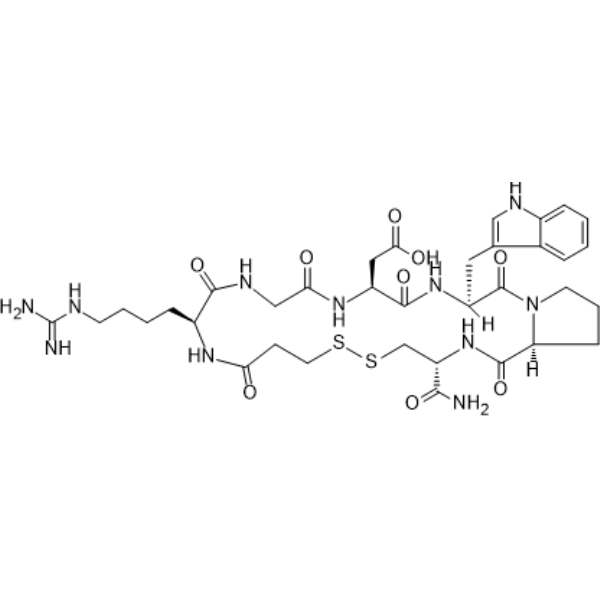
|
| DC65637 | Terlipressin Featured |
Terlipressin is a potent vasoconstrictor that acts via V1 receptors on arteriolar smooth muscle cells. Terlipressin can result in splanchnic vasoconstriction augmenting systemic arterial blood pressure with beneficial circulatory and renal effects that would be expected to also ameliorate the key pathophysiological changes responsible for the development of refractory ascites
More description
|
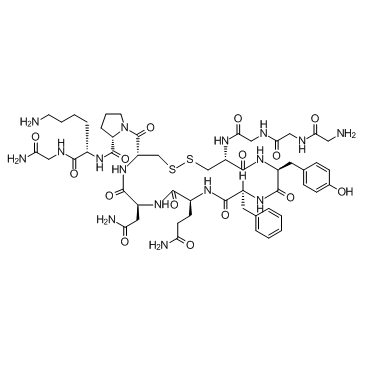
|
| DC66451 | Teriparatide Featured |
Teriparatide Free Base is a biologically active form of teriparatide, a recombinant human parathyroid hormone (PTH) analogue. It is used to treat osteoporosis in both men and postmenopausal women who are at high risk of fractures. Teriparatide works differently from most other osteoporosis medications, as it stimulates bone formation rather than just slowing bone loss.
More description
|

|
| DC65648 | Retatrutide (LY3437943) Featured |
LY3437943 is a triple agonist peptide of the glucagon receptor (GCGR), glucosedependent insulinotropic polypeptide receptor (GIPR), and glucagon-like peptide-1 receptor (GLP-1R). LY3437943 inhibits for human GCGR, GIPR, and GLP-1R with EC50 values of 5.79, 0.0643 and 0.775 nM, respectively. LY3437943 can be used for the research of obesity.
More description
|

|
| DC23914 | Thymalfasin Featured |
An immunoactive peptide that has been shown to inhibit cell proliferation and induce apoptosis in human leukemia, non-small cell lung cancer, melanoma, and other human cancers.
More description
|
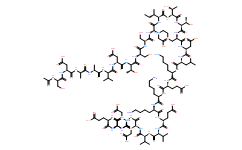
|
| DC9553 | Carbetocin Featured |
Carbetocin (marketed under brand names such as Lonactene and Duratocin) is a synthetic analogue of oxytocin, specifically designed for use in obstetrics to prevent and manage postpartum hemorrhage (PPH), a leading cause of maternal mortality worldwide. It is a long-acting agonist of peripheral oxytocin receptors, making it highly effective in inducing uterine contractions and reducing bleeding after childbirth.
More description
|

|
| DC67100 | Cetrorelix Featured |
Cetrorelix is a potent gonadotrophin-releasing hormone (GnRH) antagonist. Cetrorelix inhibits the endogenous luteinizing hormone surge during ovarian stimulation. Cetrorelix reduces cyclophosphamide induced ovarian follicular destruction in mice.
More description
|

|
| DC70134 | Oxytocin Featured |
A peptide hormone and neuropeptide that is released into the bloodstream as a hormone in response to stretching of the cervix and uterus during labor and with stimulation of the nipples from breastfeeding.
More description
|

|
| DC23939 | Atosiban Featured |
Atosiban (RW22164; RWJ22164) is indeed a nonapeptide and a competitive antagonist of the vasopressin and oxytocin receptors. It is structurally similar to oxytocin but lacks the amino group at the N-terminus, making it a desamino-oxytocin analogue. Atosiban is primarily used as a tocolytic agent, which means it helps to inhibit premature labor by blocking the action of oxytocin on the uterus. This makes it particularly valuable in the management of spontaneous preterm labor, as it can help delay delivery, providing critical time for administering corticosteroids to enhance fetal lung maturity or for transferring the mother to a facility with appropriate neonatal care.
More description
|
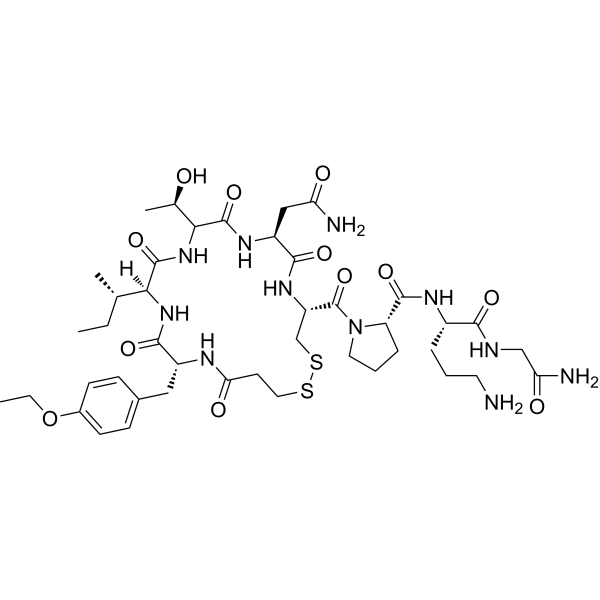
|
| DC73949 | CMP05-7 Featured |
CMP05-7 (Endosomolytic compound CMP05-7) is a novel endosomolytic small-molecule compound that exhibits higher transfection efficiency/ability to induce endosomal escape of oligonucleotides (ONs) than current compounds such as chloroquine.
More description
|

|
| DC74372 | CDD-1281 Featured |
CDD-1281 (CDD1281) is a potent, selective inhibitor of BMP type 2 receptor BMPR2 with IC50 of 1.2 nM and Kiapp value of 8 nM.
More description
|

|
| DC66463 | FAPI-46-NOTA Featured |
NOTA-FAPI-46 is an analogue of FAPI-46 (MedKoo Cat#207189). NOTA-FAPI-46 is useful in the diagnosis or treatment of a disease characterized by overexpression of fibroblast activation protein (FAP). NOTA-FAPI-46 can be used as a PET tracer for detection of diseases or disorders related to fibroblast activation protein.
More description
|

|
| DC66461 | SH-FAPI-4 Featured |
SH-FAPI-4 is a specific fibroblast activation protein inhibitor (FAPI) compound that belongs to the FAPI family of molecules. SH-FAPI-4 is expected to selectively accumulate in FAP-positive tumors and disrupt the functions of cancer-associated fibroblasts (CAFs) within the tumor microenvironment. By inhibiting FAP activity, this compound aims to potentially slow tumor growth, enhance the efficacy of other cancer treatments, and modulate the tumor microenvironment.
More description
|

|
| DC12287 | delta-Valerobetaine Featured |
Delta-Valerobetaine is a precursor of trimethylamine N-oxide (TMAO).
More description
|

|
| DC65338 | Pentixafor(CPCR4-2) Featured |
Pentixafor is a synthetic, cyclic pentapeptide analog of stromal cell-derived factor-1 (SDF-1 or CXCL12), which is the natural ligand for the C-X-C chemokine receptor type 4 (CXCR4). CXCR4 is a chemokine receptor that plays a critical role in tumor growth, progression, invasiveness, and metastasis. Pentixafor is designed to target CXCR4, which is overexpressed in various cancers and is associated with poor differentiation and aggressive disease.
More description
|
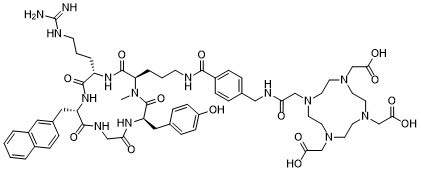
|
| DC40061 | DOTATATE Featured |
DOTATATE is a powerful tool in nuclear medicine, enabling the diagnosis and treatment of somatostatin receptor-positive tumors, particularly neuroendocrine tumors. When labeled with radionuclides like Ga-68 or Lu-177, it provides highly sensitive imaging and targeted therapy, making it a cornerstone in the management of these cancers. Its theragnostic potential allows for personalized treatment strategies, improving patient outcomes.
More description
|

|
| DC66469 | DOTA-NOC Featured |
DOTA-NOC (DOTA-Nal3-octreotide) is a high-affinity ligand of somatostatin receptor subtypes 2, 3 and 5. DOTA-NOC can be used for labeling with various radiometals, and development of radiopeptide imaging.
More description
|

|
| DC67285 | DOTA-Octreotide Featured |

|
|
| DC74649 | NOTA-TATE Featured |

|
|
| DC67284 | NOTA-NOC Featured |

|
|
| DC50044 | Edotreotide Featured |
Edotreotide is a synthetic somatostatin analogue that is used in nuclear medicine for the diagnosis and research of certain types of cancers, particularly neuroendocrine tumors (NETs). Somatostatin is a peptide hormone that inhibits the release of several other hormones, and many neuroendocrine tumors overexpress somatostatin receptors (SSTRs), making them ideal targets for somatostatin analogues like edotreotide.
More description
|

|
| DC66468 | NOTA-octreotide Featured |
NOTA-octreotide is a ligand for making [18F]AlF-NOTA-octreotide, which is a PET/CT imaging agent for somatostatin receptor imaging in neuroendocrine tumor patients
More description
|

|
| DC66467 | F-PSMA 1007 Featured |

|
|
| DC65339 | HBED-CC-tris(tBu) ester Featured |

|
|
| DC60103 | PSMA11 Featured |
PSMA-11 is a critical tool in nuclear medicine, enabling the synthesis of Ga-68-PSMA-11 for PET imaging of PSMA-expressing tumors. Its high specificity for PSMA, combined with the favorable properties of Ga-68, makes it a valuable diagnostic agent in the management of prostate cancer and potentially other malignancies.
More description
|

|
| DC33611 | PSMA-617 Linker Featured |
Vipivotide tetraxetan Ligand-Linker Conjugate (PSMA-617 Ligand-Linker Conjugate) is widely used in the treatment of metastatic castration-resistant prostate cancer (mCRPC) due to its ability to deliver targeted radiation directly to PSMA-expressing cancer cells, minimizing damage to surrounding healthy tissues.
More description
|

|
| DC12162 | PSMA-617 Featured |
PSMA-617 is a high potent prostate-specific membrane antigen (PSMA) inhibitor, with a Ki of 0.37 nM.
More description
|

|